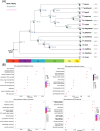An expanded odorant-binding protein mediates host cue detection in the parasitic wasp Baryscapus dioryctriae basis of the chromosome-level genome assembly analysis
- PMID: 39256805
- PMCID: PMC11389331
- DOI: 10.1186/s12915-024-01998-8
An expanded odorant-binding protein mediates host cue detection in the parasitic wasp Baryscapus dioryctriae basis of the chromosome-level genome assembly analysis
Abstract
Background: Baryscapus dioryctriae (Chalcidodea: Eulophidae) is a parasitic wasp that parasitizes the pupae of many Pyralidae members and has been used as a biological control agent against Dioryctria pests of pinecones.
Results: This B. dioryctriae assembly has a genome size of 485.5 Mb with a contig N50 of 2.17 Mb, and scaffolds were assembled onto six chromosomes using Hi-C analysis, significantly increasing the scaffold N50 to 91.17 Mb, with more than 96.13% of the assembled bases located on chromosomes, and an analysis revealed that 94.73% of the BUSCO gene set. A total of 54.82% (279.27 Mb) of the assembly was composed of repetitive sequences and 24,778 protein-coding genes were identified. Comparative genomic analysis demonstrated that the chemosensory perception, genetic material synthesis, and immune response pathways were primarily enriched in the expanded genes. Moreover, the functional characteristics of an odorant-binding protein (BdioOBP45) with ovipositor-biased expression identified from the expanded olfactory gene families were investigated by the fluorescence competitive binding and RNAi assays, revealing that BdioOBP45 primarily binds to the D. abietella-induced volatile compounds, suggesting that this expanded OBP is likely involved in locating female wasp hosts and highlighting a direction for future research.
Conclusions: Taken together, this work not only provides new genomic sequences for the Hymenoptera systematics, but also the high-quality chromosome-level genome of B. dioryctriae offers a valuable foundation for studying the molecular, evolutionary, and parasitic processes of parasitic wasps.
Keywords: Baryscapus dioryctriae; Hi‐C; Odorant-binding protein; Parasitic wasp.
© 2024. The Author(s).
Conflict of interest statement
The authors declare that they have no competing interests.
Figures






References
-
- Ivezić A, Trudić B. Parasitoids of the genus Trichogramma (Hymenoptera: Trichogrammatidae), natural enemies of European corn borer Ostrinia nubilalis (Hübner, 1796)(Lepidoptera: Crambidae). J Cent Eur Agric. 2021;22(4):787–97. 10.5513/JCEA01/22.4.3247 - DOI
MeSH terms
Substances
LinkOut - more resources
Full Text Sources
Miscellaneous

